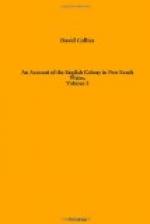Several other islands were seen to the southward, and the coast of the main seemed trending in the same direction. A deep bight lay at the back of these islands, with points and openings visible in its most distant part. There was reason to believe, that the sea here had a communication through into the unexplored bight to the eastward of Three Hummock Island; in which case the pointed part of the main, whose vegetation bore so great a resemblance to that of Three Hummock island, would also be an island. They passed sufficiently near to determine that they were high, steep, and difficult of access. Their tops and sloping parts were grown over with either coarse grass or short brush; but not any trees appeared. The largest might be seven or eight miles in circuit, the smaller were mere masses of rock of various sizes; and the whole cluster, in number about twelve, including Three Hummock Island, obtained the name of Hunter’s Isles.
A fresh gale at ENE and a heavy swell from the SW drove the vessel fast to the southward and westward; and on the 11th, the gale having moderated, they stretched in for the land, a large extent of which was indistinctly visible through a light haze that hung about the horizon. At noon the latitude was 41 degrees 13 minutes, and the longitude 148 degrees 58 minutes. With a fresh breeze at NNE they bore away along the shore, which trends to the SE by E and was distant three or four miles.
From a shore of beach, with short rocky points at intervals, the land rose gradually to a considerable height, the aspect of which was barren and brushy, and the soil sandy. Several short reefs of rocks lay in front of the beaches, and broke the long swell into a surf of a tremendous appearance.
Dreading a gale of wind from the west, which was threatening, and might have proved fatal to their little vessel, they hauled out to the SSW; but the weather remained moderate.
On the following morning the wind flew round to the northward, and they continued their route along the shore. Early in the forenoon they passed a singularly formed point, with a number of lumps of rock lying some two or three miles off it to the SW. It resembled an artificial pier, or mole, with warehouses upon it, and a lighthouse on the end next the water. Large masses of detached oblong rocks gave the appearance of warehouses, and a remarkably long one standing upon its end, that of the light-house.
Their latitude at noon was 42 degrees 02 minutes and the longitude 145 degrees 16 minutes; the coast still trended to the SSE and the land began to change that uniformly regular figure which it had hitherto preserved. It was becoming mountainous and uneven, but was still barren.




